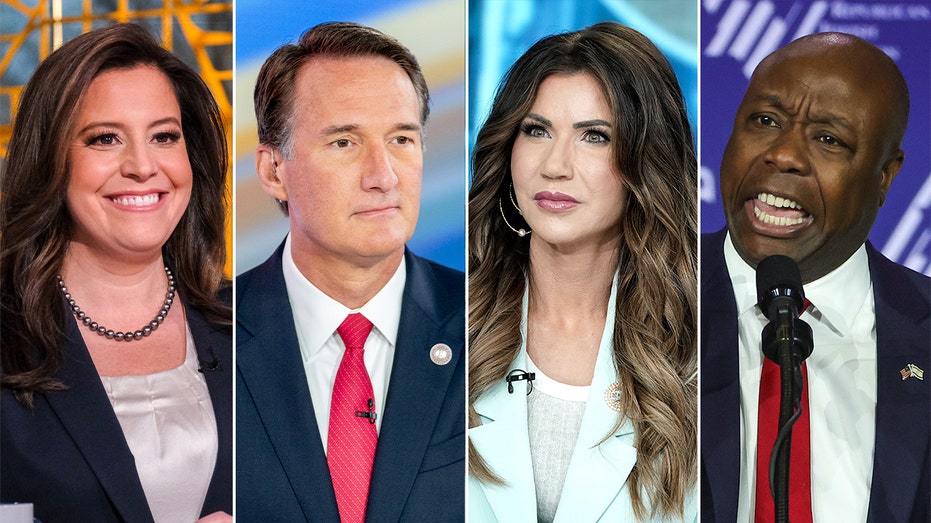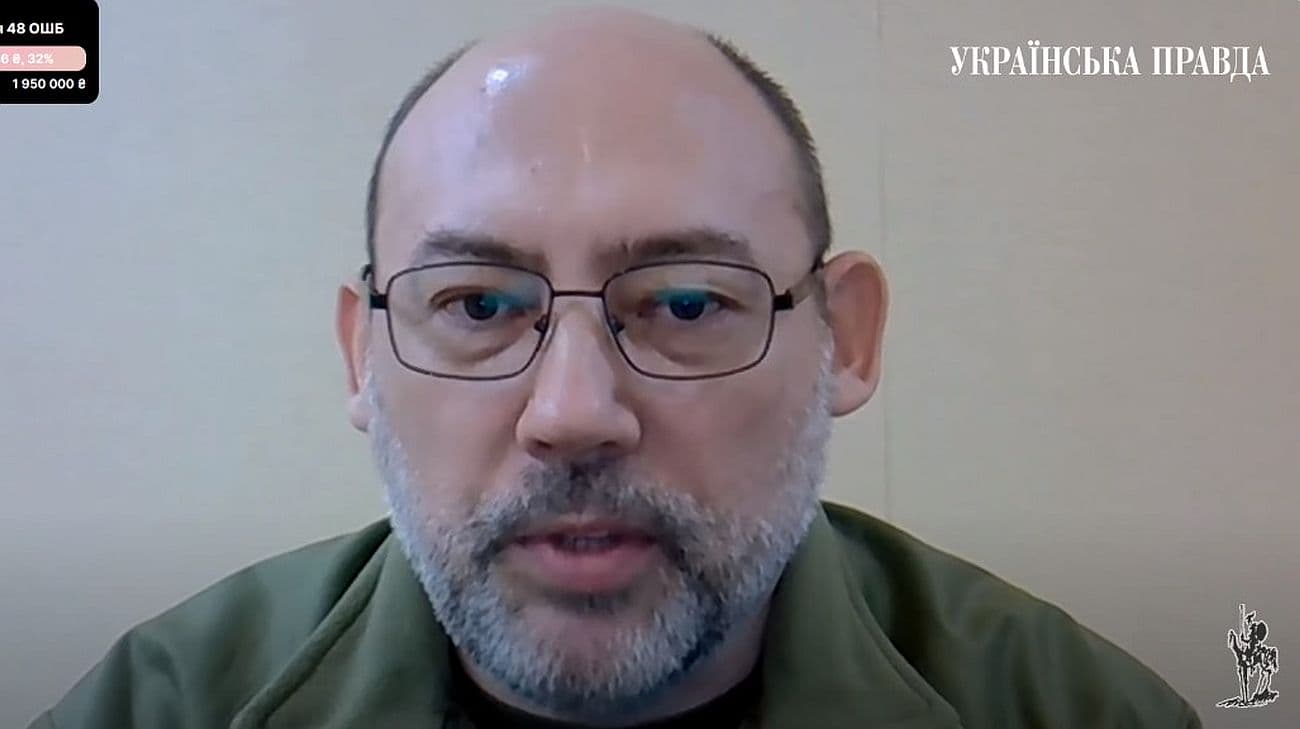Trump’s Cabinet of Horrors
Christopher Rufo, the U.S. Secretary of Education, watched the hearing with delight. It was early November 2025, almost exactly a year since Donald Trump had won his second term to the White House. Already, the nation had changed under his watch, with today’s hearing on educational indoctrination only the latest evidence of the transformation at work.Michelle Obama had not been president of Harvard University for six months, and if this grilling before the Senate Committee on Health, Education, Labor and Pensions stayed on track (and it would, because the staff of each Republican senator on the committee had been coached by White House director of legislative affairs Madison Cawthorn on which questions to ask, when, and how; the afternoon producers on Fox News had been similarly prepped), she was going to make her predecessor Claudine Gay look like a long-termer.It was delicious stuff, watching the former first lady squirm. Having already landed a couple of haymakers during the first round of questioning, the committee’s chairman, Ohio Republican Senator J.D. Vance—President Trump’s favorite bulldog on Capitol Hill and already a 2028 presidential favorite—was now launching a stemwinder about “rooting out the cancer of wokeness.” Fox News turned its camera on Michelle, who looked as if she might kill Vance—or, if this continued, herself.Secretary Rufo muted the television and rose. He was still getting used to his office, a plain room in a concrete building on Maryland Avenue, nothing like the sumptuous quarters overlooking Pennsylvania Avenue that Attorney General Laura Ingraham crowed about every time he saw her in one of the Old Ebbitt Grill back rooms, drinking what she claimed was a club soda, gossiping with special assistant to the president Chaya Raichik—better known as Libs of TikTok—about the latest West Wing intrigue. She really needed to get her ass in gear, Rufo thought. There was no time to waste. President Trump’s second term was flying by, and even if he managed to extend that term by a year or two—White House counsel Kimberly Guilfoyle was just polishing up her memorandum on how to postpone the 2028 election—there was too much work left for foot-dragging.There was a noise on the street below. He went over to the window, chuckling as he remembered that today was the Federal Workers Fight Back march. Hundreds of dismissed government employees were marching down Maryland Avenue. The demonstration was supposed to shut down Washington but had only managed to snarl the district’s traffic, which had gotten worse since Trump’s Office of Management and Budget mandated a nonnegotiable five-day return to office for all federal employees, federal contractors, and any corporation employing more than 10 individuals that either had or intended to have any business with the U.S. government, which is to say pretty much every corporation in the United States.In truth, those who still had a cubicle to return to could count themselves lucky. After his inaugural procession down Pennsylvania Avenue, Trump settled back into the Oval Office as if he had never left. This time, he knew what to do, and how to do it. His first order of business had been to sign an executive order, prepared by special assistant to the president Stephen Miller, that called for Immigration and Customs Enforcement to start rounding up undocumented immigrants already in the United States. After that, Trump had signed an executive order implementing Schedule F, which reclassified federal employees in a way that made it much easier to fire them and appoint political loyalists in their stead. With the stroke of a pen, the bloated administrative Leviathan had been deflated, with thousands of deep state bureaucrats headed for the unemployment line.Rufo’s phone rang. He groaned when he saw the caller’s avatar. It was Elise. Again. Boredom and ambition were making for a toxic combination in her case. Couldn’t Trump send her on a fact-finding mission to Taiwan. Or maybe Mars?“Madame Vice President,” he said without anything that could be interpreted as enthusiasm. Vice President Elise Stefanik launched into a long complaint about U.S. Ambassador to the United Nations Vivek Ramaswamy, who she thought was positioning himself for a 2028 run (like most of the more ambitious members of the Cabinet, she publicly supported Trump’s plan to delay the election while privately hoping it would be struck down by the Supreme Court). His blustery Turtle Bay speech about a preemptive strike on China had been well-received in the Pentagon, where Defense Secretary Michael Flynn was spoiling for a fight.She hated that, of course. “It’s my fucking turn,” Stefanik spat into the phone. “That little shit can wait until 2036.” Trump had already told her that, as his second term came to an end, he would dramatically announce that he was stepping down, having accomplished everything he had wanted to, thus giving her the power of incumbency right as the next election, wheneve

Christopher Rufo, the U.S. Secretary of Education, watched the hearing with delight. It was early November 2025, almost exactly a year since Donald Trump had won his second term to the White House. Already, the nation had changed under his watch, with today’s hearing on educational indoctrination only the latest evidence of the transformation at work.
Michelle Obama had not been president of Harvard University for six months, and if this grilling before the Senate Committee on Health, Education, Labor and Pensions stayed on track (and it would, because the staff of each Republican senator on the committee had been coached by White House director of legislative affairs Madison Cawthorn on which questions to ask, when, and how; the afternoon producers on Fox News had been similarly prepped), she was going to make her predecessor Claudine Gay look like a long-termer.
It was delicious stuff, watching the former first lady squirm. Having already landed a couple of haymakers during the first round of questioning, the committee’s chairman, Ohio Republican Senator J.D. Vance—President Trump’s favorite bulldog on Capitol Hill and already a 2028 presidential favorite—was now launching a stemwinder about “rooting out the cancer of wokeness.” Fox News turned its camera on Michelle, who looked as if she might kill Vance—or, if this continued, herself.
Secretary Rufo muted the television and rose. He was still getting used to his office, a plain room in a concrete building on Maryland Avenue, nothing like the sumptuous quarters overlooking Pennsylvania Avenue that Attorney General Laura Ingraham crowed about every time he saw her in one of the Old Ebbitt Grill back rooms, drinking what she claimed was a club soda, gossiping with special assistant to the president Chaya Raichik—better known as Libs of TikTok—about the latest West Wing intrigue. She really needed to get her ass in gear, Rufo thought. There was no time to waste. President Trump’s second term was flying by, and even if he managed to extend that term by a year or two—White House counsel Kimberly Guilfoyle was just polishing up her memorandum on how to postpone the 2028 election—there was too much work left for foot-dragging.
There was a noise on the street below. He went over to the window, chuckling as he remembered that today was the Federal Workers Fight Back march. Hundreds of dismissed government employees were marching down Maryland Avenue. The demonstration was supposed to shut down Washington but had only managed to snarl the district’s traffic, which had gotten worse since Trump’s Office of Management and Budget mandated a nonnegotiable five-day return to office for all federal employees, federal contractors, and any corporation employing more than 10 individuals that either had or intended to have any business with the U.S. government, which is to say pretty much every corporation in the United States.
In truth, those who still had a cubicle to return to could count themselves lucky. After his inaugural procession down Pennsylvania Avenue, Trump settled back into the Oval Office as if he had never left. This time, he knew what to do, and how to do it. His first order of business had been to sign an executive order, prepared by special assistant to the president Stephen Miller, that called for Immigration and Customs Enforcement to start rounding up undocumented immigrants already in the United States. After that, Trump had signed an executive order implementing Schedule F, which reclassified federal employees in a way that made it much easier to fire them and appoint political loyalists in their stead. With the stroke of a pen, the bloated administrative Leviathan had been deflated, with thousands of deep state bureaucrats headed for the unemployment line.
Rufo’s phone rang. He groaned when he saw the caller’s avatar. It was Elise. Again. Boredom and ambition were making for a toxic combination in her case. Couldn’t Trump send her on a fact-finding mission to Taiwan. Or maybe Mars?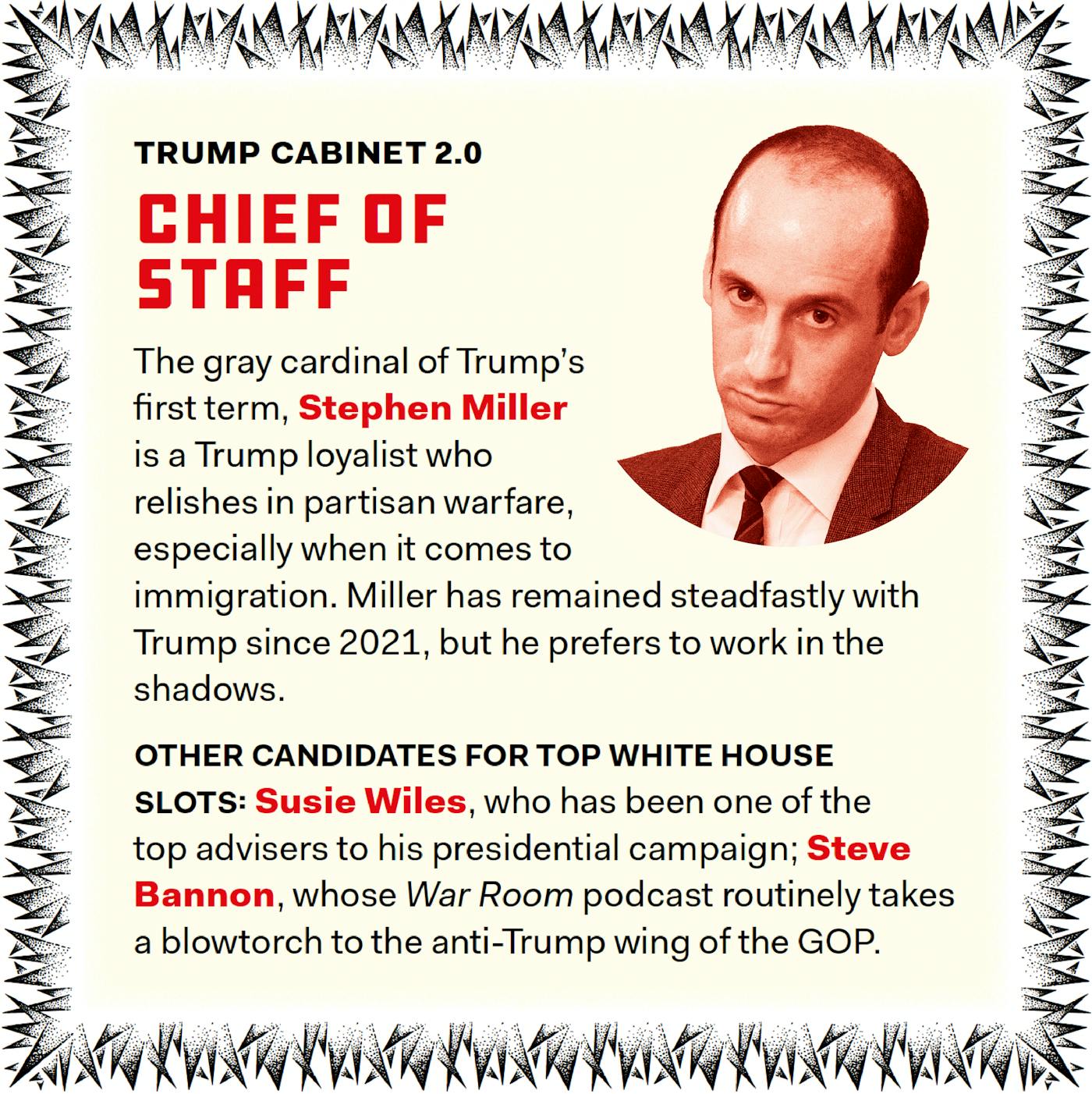
“Madame Vice President,” he said without anything that could be interpreted as enthusiasm. Vice President Elise Stefanik launched into a long complaint about U.S. Ambassador to the United Nations Vivek Ramaswamy, who she thought was positioning himself for a 2028 run (like most of the more ambitious members of the Cabinet, she publicly supported Trump’s plan to delay the election while privately hoping it would be struck down by the Supreme Court). His blustery Turtle Bay speech about a preemptive strike on China had been well-received in the Pentagon, where Defense Secretary Michael Flynn was spoiling for a fight.
She hated that, of course. “It’s my fucking turn,” Stefanik spat into the phone. “That little shit can wait until 2036.” Trump had already told her that, as his second term came to an end, he would dramatically announce that he was stepping down, having accomplished everything he had wanted to, thus giving her the power of incumbency right as the next election, whenever that would be, approached. She was going to steamroll Kamala, or Mayor Pete, or whoever the Dems dredged up, especially if the new round of individual tax cuts passed Congress next year. And House Speaker Marjorie Taylor Greene had promised that they would. After all, she had ambitions of her own.
“Of course, Madame Vice President,” Rufo said.
Harvard graduates are the worst, he thought. Yes, he had a master’s degree from the Harvard Extension School, but this was different. He was different. Everything was different now. This time around, Trump had restrained his own obsessions with credentials. Finally, the boss had listened to special assistant to the president Stephen K. Bannon, who argued—just as he had during the first Trump term, only more effectively this time—that Ivy Leaguers were inherently prime suspects for membership in the deep state.
With Schedule F having cleared the bureaucratic deadwood, enormous swaths of the executive branch were subject to direct appointment from the president. No more Senate hearings, no more hand-wringing over whether he could fire the Anthony Faucis of the world. Of course he could! He could now fire just about everyone, making government both smaller and more loyal to him.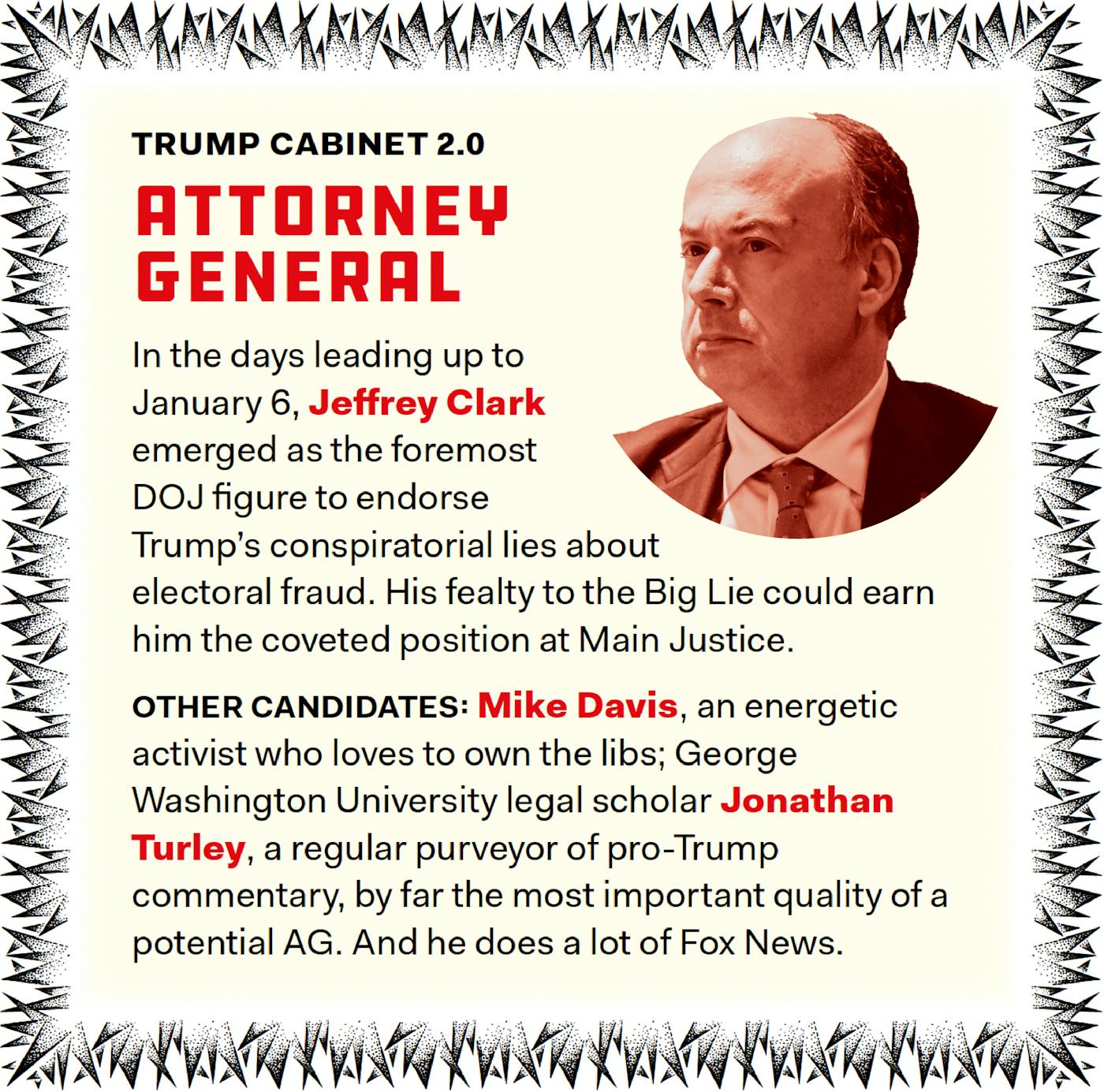
And despite what the critics were saying, Kid Rock was going to do a fine job at the Department of the Interior, once he got the hang of his division. It was only a matter of time. Same with Candace Owens at the Environmental Protection Agency. Besides, everyone knew they were just there to troll the libs and distract from the real work, which was being done by anonymous functionaries selected for the administration by the Heritage Foundation: shy ideologues who dressed in muted grays and blues and lived in Leesburg and knew the rulemaking process like it was the alphabet. They were the ones who were finally doing the work of dismantling the administrative state, returning power to the unitary executive, just as the Founding Fathers had intended. They didn’t want to own the libs; they wanted to defeat them. And all was going to plan. So much winning.
“Extraordinarily Dangerous”
A caveat is in order: The New Republic cannot predict the future. Thing is, we don’t really have to. Trump and his associates—still-loyal veterans from the first term, Washington think-tankers, Mar-a-Lago insiders, conservative TV pundits, lawyers imbued with “America First” fervor—have been telling us for months, years even, what a second Trump term would look like. And while the above is obviously a fiction (and, admittedly, we did get a little creative there), it is not at all a fantasy, sourced from publicly available plans being drafted in Washington and South Florida right now.
“There’s excitement,” one former Trump administration official told me. Loyalists from the first term who held their tongues after January 6 and turned down book deals and CNN hits will likely find themselves in high-ranking positions. Meanwhile, conservative organizations like American Moment (its mission: to “identify, educate, and credential”) are training an entire cadre of young conservatives who could fill executive branch ranks thinned by Schedule F and voluntary departures.
Allies are also assembling an army of lawyers who aren’t merely conservative but actively zealous about carrying out a radical MAGA agenda. “They need much stronger attorneys who do not care about elite opinion who will fight these key cultural battles,” judicial activist Mike Davis told The New York Times last fall. No retiring types this time, with their worries about the Constitution and the rule of law.
Many of the groups now building out a proto-Cabinet are run by former Trump staffers who know exactly what the boss will be looking for: Johnny McEntee, who is helping lead the Heritage Foundation’s Project 2025—an especially ambitious initiative that has already published a 920-page “manual” for Trump’s second term—had come to be known as “deputy president” by late 2020. At the time, the former University of Connecticut quarterback with a gambling problem was improbably helming the White House personnel office, which he used to enforce loyalty to Trump across the executive branch, to the extent that he could. Now McEntee is doing something that Trumpworld is not generally known for: preparing.
Another former Trump administration staffer expressed annoyance at what he described as “jockeying” by some figures to be included on lists of potential Cabinet members like the one published by Axios in December, lists that will likely proliferate more aggressively as the general election nears. Vanity Fair reported that Jared Kushner is being considered for secretary of state; shortly thereafter, another report had him vowing to avoid Washington if there was a second Trump term. Politico, meanwhile, puts Senator Tom Cotton and former Secretary of State Mike Pompeo, among others, on a list of potential Pentagon chiefs.
“Too early to talk about Cabinet,” campaign spokesman Steven Cheung told me in a text message, declining to answer any questions. The Axios list may have driven web traffic, but some reporters in Washington grumbled that it was a little slapdash. The campaign appeared annoyed, too, maintaining its uncharacteristically professional demeanor to an almost uncanny extent. “Everyone should be suspicious of what’s being put out there,” the second former Trump staffer said. “The campaign team is just focusing on winning.”
“President Trump has been straightforward about his goals and objectives for second term,” Bannon told me in a text message, describing a “mass deportation effort” targeting undocumented immigrants and disengagement from Ukraine and other global hot spots. Above all, a second Trump term would most likely be shaped by Trump’s personal grievances, which are manifold—the 2020 election, January 6, his handling of classified documents after his term in office ended, the perceived leniency of the Justice Department when it comes to the financial dealings of the Biden family, Hunter Biden in particular—but centered around the overwhelming conviction that the federal law enforcement apparatus has been “weaponized” against Trump, Trumpism, and its adherents. He has done nothing to hide his intentions on this front. “The Biden regime’s weaponization of our system of justice is straight out of the Stalinist Russia horror show,” Trump said at a campaign rally in Texas last year.
Good-government advocates see a highly politicized Department of Justice less concerned with enforcing the law than punishing enemies. We’re talking the kind of stuff that would make Tricky Dick look like Honest Abe: nakedly political prosecutions, the full power of federal law enforcement crashing down on critics, the Bidens and Clintons above all. Liberals could well end up pining for the day when Jeff Sessions was the attorney general if either an election-denying lickspittle like Jeffrey Clark or an ideological firebrand like Mike Davis is in charge at Main Justice. “It would be extraordinarily dangerous and would undermine our democracy and our society,” said Max Stier, president of the nonpartisan Partnership for Public Service.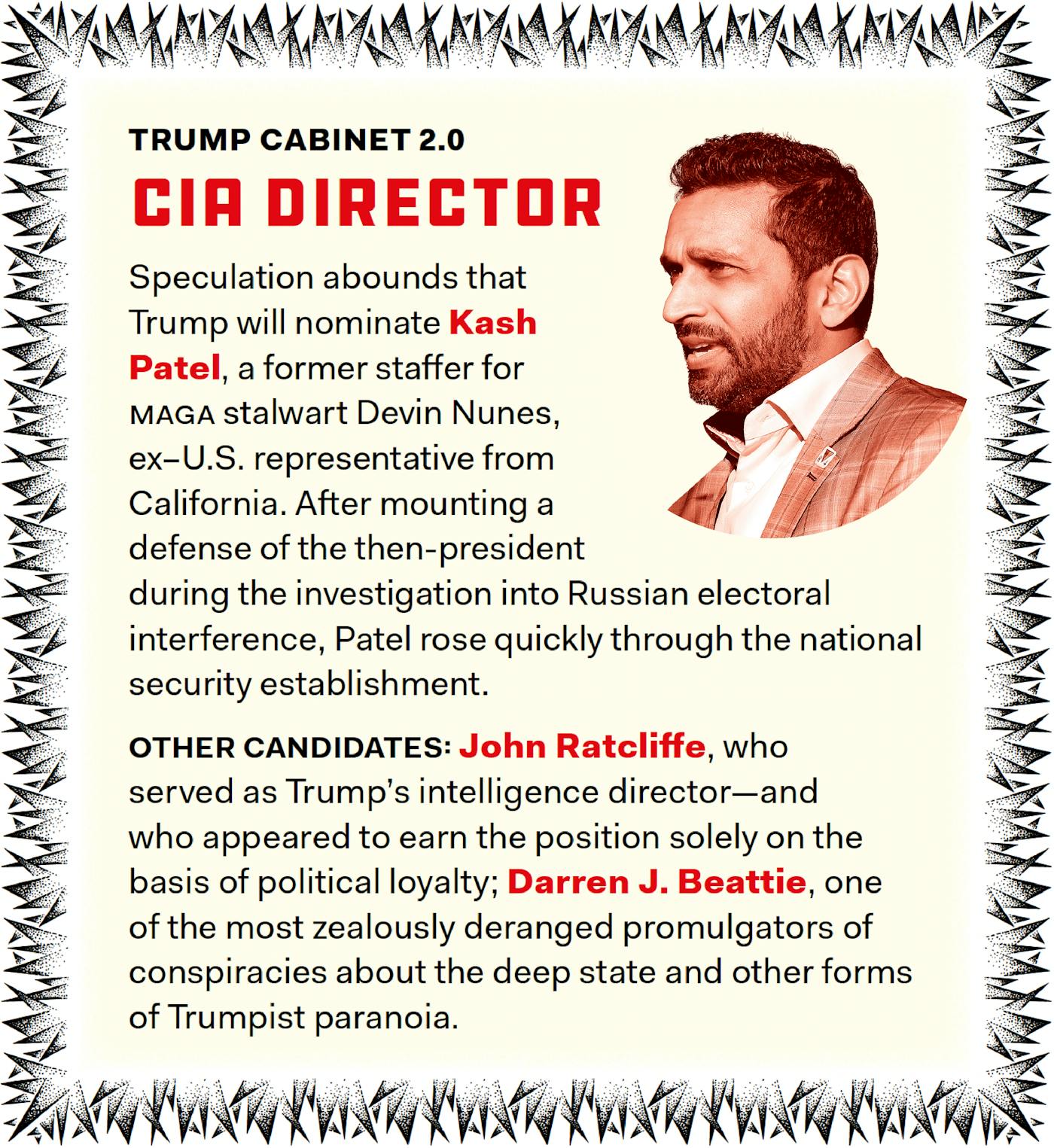
There are other risks in other departments. Rules may be less sexy than laws, but most of the federal bureaucracy thrives on the former. Rulemaking, on some basic level, is what government is all about. In a second Trump term, there will be a lot fewer of them—except in culture war hot spots, where rules will proliferate. And they will be implemented by Cabinet members far more capable than the first term’s gang of misfits.
The First Term: Wait, We Won?
In 2019, I wrote a book, The Best People, about Trump’s Cabinet: the people, what they did, what they wrecked, and, in many cases, what brought them down. The title was on the ironic side. When I interviewed Trump in the Oval Office, he needed an assistant to bring him a sheet with their names and accomplishments. Hilariously, she inadvertently brought out a letter from Kim Jong Un, which Trump was probably not supposed to show me but, of course, very proudly did. Then the right papers materialized, and Trump mumbled through some names that did not seem entirely familiar, before turning to the topic of Jussie Smollett, the actor who’d faked a hate-crime attack against himself in Chicago.
You can’t blame the big fella for having been less than impressed with figures like Health Secretary Tom Price or Veterans Affairs chief David Shulkin, both of whom, because of ethical scandals, had resigned by the time Trump and I spoke. It was never supposed to be an administration of Prices or Shulkins. But just who was supposed to serve Trump? That, they never quite figured out.
Few of the executive branch chiefs turned out to be the relentlessly capable, religiously dedicated populists envisioned by the likes of Bannon, the chief architect of Trump’s 2016 win who was himself out of the administration by mid-2017. Instead, there were opportunistic oddballs like Environmental Protection Agency administrator Scott Pruitt, who did the Lord’s work in feeding Washington’s rumor mill on a near-daily basis; sycophants like Steven Mnuchin, the treasury secretary, and people who should never have been anywhere near a federal department in the first place. By the time genuinely competent, or at least outwardly professional, figures like Trade Representative Robert Lighthizer, budget director Russell Vought, and Health Secretary Alex Azar actually began to wield influence, it was too late to right the floundering ship that was the Trump presidency.
The disorder that would plague Washington for four unrelenting years originated in part during those delirious late-night hours of November 8, 2016. “They had no transition plan,” said Republican operative Colin Reed. The presidential transition was nominally run by former New Jersey Governor Chris Christie, but he had lost favor by joining in the criticism of Trump after the Access Hollywood recording was released in October (at least that is Bannon’s version of events; Christie, naturally, disputes it). They had no plan because they figured there was nothing to plan for. Why plan for the demise of a glorious spectacle, a lark that had gone on for far too long? Then, the numbers from Michigan and Wisconsin started to come in…. Oh shit, oh shit, oh fuck. FUCK. “We were not jubilant,” Bannon later told me. In his penthouse apartment, Trump was beginning to realize the significance of the moment, Bannon recalled. “It was like, ‘This is real now.’”
The transition included a frenetic series of interviews in Trump Tower. Kanye West arrived to discuss “multicultural issues.” Barry Switzer, the former Dallas Cowboys coach, showed up, though it wasn’t clear if he and Trump actually had a face-to-face. Seeming to grasp and play into the surreal essence of the moment, he said he was going to serve as Trump’s “secretary of offense,” which was a funny enough quip but didn’t answer the question of what, exactly, ol’ Gunsmoke was doing in New York, and what role he had to play in the transfer of presidential power (the ultimate answer, thankfully: none). Also came Al Gore, the former vice president, who said he and the president-elect had “an extremely interesting conversation.” No doubt they did.
With thousands of political appointments to fill, Trump’s transition team needed all the help it could get. Many of the same establishment conservatives who had been denouncing Trump weeks, or even days, earlier, now saw an opportunity for immense advancement.
The executive branch—including the West Wing itself, as memorably captured in Michael Wolff’s Fire and Fury—played host to factional warfare between MAGA janissaries entirely unsuited to government work (see: Gorka, Sebastian), Republican National Committee functionaries who loathed Trump but pretended for now not to, Heritage Foundation wonks who had a mission to accomplish and didn’t especially care about Trump’s latest social media feud with a C-list celebrity. “Every day was a knife fight,” Bannon remembered.
This time around, Trump and the establishment Republicans who find themselves beholden to him once again are determined not to repeat that mistake.
The Second Term: Experience Counts
Remember when Florida Governor Ron DeSantis was leading Trump in the Iowa polls? Shortly after his smashing reelection victory in 2022, a poll commissioned by the Club for Growth found the blustery young Floridian beating Trump by 11 points in the key battleground state of Iowa.
Trump left Iowa with the largest margin of victory in caucus history. Yes, DeSantis turned out to be one of the most incompetent major political candidates in recent memory. But there was another, arguably more important component to Trump’s astonishing win, one that gives clues to what his second term might look like: organization. Several days before the caucus, political scientist Barbara A. Trish, of Iowa’s prestigious Grinnell College, observed that Trump’s operation was nothing like the one she had witnessed in 2016, when he came in second to Senator Ted Cruz of Texas.
“Trump’s caucus events are different,” she wrote, describing a concerted effort to register prospective voters, explain caucus rules, and train caucus captains who would be deployed on Election Day to make the final push. Trish saw “some deeper meaning in the former president signing off on an effort to build an organization,” a sign of things to come. “And it just might give Democrats even more cause for concern,” she wrote. “A second term might be fueled with a little more political know-how to advance the Trump agenda.”
The 2024 Trump campaign is hardly the freewheeling 2016 shit show that burned through campaign managers and moved with as much intention as a caffeinated hamster. This time, led by Chris LaCivita and Susie Wiles from South Florida, the campaign has been ruthlessly organized. “These are professional operators. They run a tight ship,” said Reed, who worked on a political action group that supported Christie in the 2024 primary cycle. Just like Grinnell professor Trish, Reed believes that if Trump wins, his presidency will mirror the professionalism of the winning campaign.
That is precisely what worries progressives. The one consolation of the first Trump term was that it was chaotic, farcical, and incompetent. To be sure, there was a lot of harm done, a lot of malice injected into the body politic. But it could have been much worse. This time, Reed said of Trump, “he’ll have nothing holding him back.”
The ambitions of a second Trump term are clearly, thoroughly outlined in Mandate for Leadership: The Conservative Promise, a 920-page book published by the Heritage Foundation’s Project 2025. It’s a hell of a playbook, one that should thrill conservatives and terrify liberals. It suggests a more focused, intentional Trump administration 2.0, one that realizes it has little time to waste if it wants to undo what it sees as the damaging developments—cultural, economic, diplomatic—of Biden’s four years in office.
Each section of the book is concerned with a different department or branch of the federal government: the intelligence community, the Department of Education, et cetera. Together, the dozens of contributors who collaborated on Mandate have created something between a do-over and a wish list—right-wing fan fiction that could turn out to be all too real. Authors and advisers include familiar names like anti–voting rights activist Hans von Spakovsky; abortion foe Roger Severino; economists like supply-sider Stephen Moore and China hawk Peter Navarro; the nativist Ken Cuccinelli, who headed the Department of Homeland Security in an acting capacity; Trump’s deputy chief of staff Rick Dearborn; and Gene Hamilton, who worked on the Trump administration’s policy of separating migrants from their children at the border.
Mandate calls for pornography to be banned and deems the Dobbs decision, which nullified the federal protection for abortion rights guaranteed by Roe v. Wade, “just the beginning.” The Transportation Security Administration would be privatized; transgender service members would be kicked out of the military; the current administration’s “climate fanaticism” would be rolled back (a top priority of the right’s energy revanchists); and National Public Radio, that dastardly purveyor of “leftist opinion,” would lose its funding.
Heritage and its Project 2025 have a rival in the America First Policy Institute, another Washington think tank whose staff and board include former Trump staffers and surrogates. afpi wants to give parents more say in secondary education, as DeSantis has done in Florida, empowering extremist groups like Moms for Liberty; increase oil and gas drilling; implement voter identification laws and take other steps that would make it more difficult for certain Americans to vote; and give gun owners “concealed carry reciprocity across all 50 states,” thus effectively invalidating state and local restrictions put in place mostly by Democrats.
These proposals have all been part of the conservative mantra for years. What’s striking about them is the work afpi and Heritage and other institutions have done in systematizing their plans, preparing both people and policies for January 20, 2025, when they hope to see Trump back at the U.S. Capitol, his hand once more on the Lincoln Bible.
This time around, there won’t be any clueless wandering around the West Wing, searching for light switches, wondering where to get a midnight snack. It’s now or never. Move fast and break things, as the techies say. MAGA has its sledgehammers ready.
A Second-Term Bestiary
It was an axiom of the Reagan years that “personnel is policy.” The best playbook won’t matter much if your quarterback can’t throw and your wide receiver can’t catch. To execute the ambitious plans outlined in Mandate for Leadership, Trump will need a cadre of highly capable, unimpeachably loyal functionaries. “He doesn’t want anybody in there with their own ideas. He just wants people who are going to do what he asks,” said Pat Dennis, president of Democratic research firm American Bridge 21st Century. “Authoritarians do not simply rule by diktat. They have people whom they need to maintain in their circle, and they do that by providing the spoils of government.”
Every executive branch department is a complex interplay among career public servants, midlevel political appointees, and the Cabinet secretaries themselves. There are 2.9 million federal employees, and the president has more than 4,000 political appointments at his discretion. Schedule F would make another 50,000 government workers subject to political whims.
How each of those factions wields power, and how those factions either join forces or clash is impossible to predict. It’s not especially easy to manage either; all the deep state fulmination from Bannon and his ilk was less an explanation than an excuse. The federal bureaucracy got the best of them, and they knew it.
“One has to wonder whether people in the Department of Justice or the military are really going to be willing to do Trump’s bidding when he is demanding things that are patently outside the law,” said Michael Isikoff, an investigative reporter who co-wrote Find Me the Votes, a book about Trump’s attempt to subvert the 2020 election, with Daniel Klaidman (they are both former colleagues of mine at Yahoo News). “They’ve got law licenses to worry about.” Not to mention reputations. One gets the sense that, this time, book deals and MSNBC contributorships are going to be much more scarce. Between all the former Trump staffers who want nothing to do with Trump, and how many establishment figures Trump wants nothing to do with, it is not entirely clear who is going to join his second-term administration.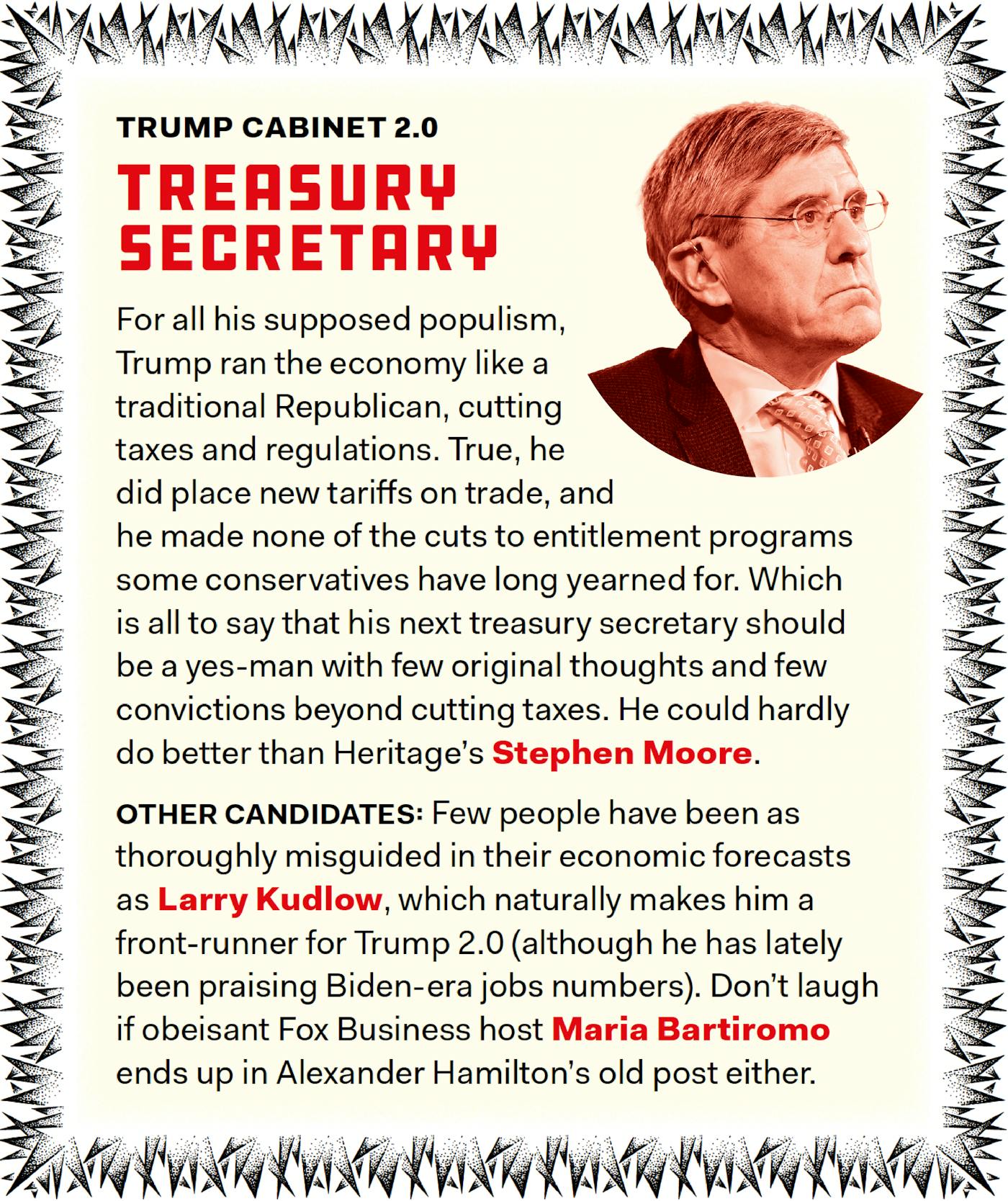
Bannon told me that affirming the lie that Trump won the 2020 election will be crucial for anyone hoping to fill a high-profile post. “As President Trump prizes intelligence as a key factor in making great leaders, no smart person could possibly think the Biden Regime is legitimate. Impossible,” he said in a message passed along by his longtime publicist Alexandra Preate. Bannon is not affiliated with the campaign, but a high-ranking AFPI official told me he also believes that Trump and his inner circle are aware of which potential supplicants have denounced Trump’s lies—and which ones haven’t.
The prospective list put out by Axios in December was instantaneously controversial and has been debated ever since. But most everyone believes that Stephen Miller, a loyal adviser who crafted Trump’s immigration policy, will return to the West Wing. He would rather wield influence in the Oval Office, insiders say, than have a spacious Cabinet secretary’s office of his own.
Besides, Miller is said to be aware that he could never pass confirmation by a Senate, even one narrowly controlled by Republicans. The same problem could bedevil prospective nominees like Tucker Carlson, who Axios said was being considered for secretary of state in a second Trump term.
Another common refrain is that Kash Patel, the former staffer to Representative Devin Nunes who curried favor with Trump by stoking his conspiratorial suspicions of the Justice Department and the intelligence community, could be rewarded with the directorship of the Central Intelligence Agency, or a similarly high-profile position. Patel is on the Axios list, too.
Democratic operative Will Ragland, who works on the political arm of the Center for American Progress, shared his own mock-up of a Trump second-term Cabinet. It goes without saying that Ragland does not have close ties to the Trump campaign, exactly, but his selections struck me as persuasive all the same, imbued with an understanding of what Trump values and why. It includes the discredited former White House doctor Ronny Jackson as the health secretary, the alleged sex trafficker Representative Matt Gaetz as the U.S. ambassador to the United Nations, embattled Texas Attorney General Ken Paxton as the director of national intelligence, and South Dakota Governor Kristi Noem at Interior. Representative Taylor Greene will have to make do with the Small Business Administration.
One former Trump official said that there were just enough capable people to fill the top ranks of the administration. But what of the many ranks below cleared through Schedule F? “The next level of people is worrisome,” he acknowledged. He hoped that Doug Burgum, the North Dakota governor who launched a long-shot, short-lived presidential bid, got something: EPA, maybe, or Energy. That would soothe his worries. A little.
Rufo, the conservative activist, was working on his farm in the Seattle area when I reached out to him. Yes, he would serve in a second Trump administration either as education secretary or in another capacity, he told me, though he said such conversations have not taken place. Still, Rufo is close enough to education policymakers in Trump’s circle to have a good sense of what they intended to do should they come to power again.
“The federal government is the single largest funder and supporter of woke ideology in the world,” he lamented. It was a development he hoped Trump 2.0 would undo, investigating colleges for their admissions policies and equity initiatives while scrutinizing what K–12 schools teach and assign. He thought the goal of the federal Education Department during a second Trump term should be to “put the left’s ideological apparatus in crisis” by cutting off funding, launching investigations, and applying pressure, more or less as DeSantis has done in Florida.
“Governor DeSantis has demonstrated year in and year out how power works, how institutions work, how the law works,” he told me approvingly, hoping for something similar during a second Trump term.
Nobody has enjoyed the speculation more than Mike Davis, a former high-ranking adviser to Senator Chuck Grassley of Iowa. The young and brash judicial activist helped shepherd Brett Kavanaugh through a brutal confirmation process and has been a MAGA loyalist. For the record, Davis does not think he will be the next attorney general, but he courts speculation all the same. He says what he’d really like is to become Washington’s “viceroy” once Republicans do away with the district’s home rule. He laughs into the phone, a hearty cackle I’ve come to sort of appreciate through the years. “I’m fucking with people,” he told me.
Not everyone is alarmed by the prospects of another four years of Trump. Reed, the Republican consultant, thinks a lot of the anxiety is being peddled by left-leaning outlets like MSNBC in a cynical if-it-bleeds-it-leads ploy, knowing that nobody gets quite as many clicks and views as Trump. “The guardrails of democracy held last time,” Reed said. And he believes they will hold again.
Isikoff, the investigative reporter, agreed, arguing that even with Schedule F in place, there will be too many midlevel officials, including some political appointees, who refuse to do Trump’s bidding. “You’ll have paralysis in the government. People will just refuse to do his bidding. There will be mass resignation. I can foresee civil disobedience,” Isikoff predicted.
But others call this a Pollyannaish outlook, especially when it comes to Trump using the federal government to punish opponents, whether it’s a Department of Energy staffer with pronouns in their email signature or Hunter Biden. After all, Trump has been nothing if not clear about why he is running, and what he will do if he wins.
“It’s folly not to take Trump at his word on this one,” the constitutional scholar Kim Wehle told me. “In 2016, Trump did not have the list of grievances he has now. It could get very ugly—and scary.”


